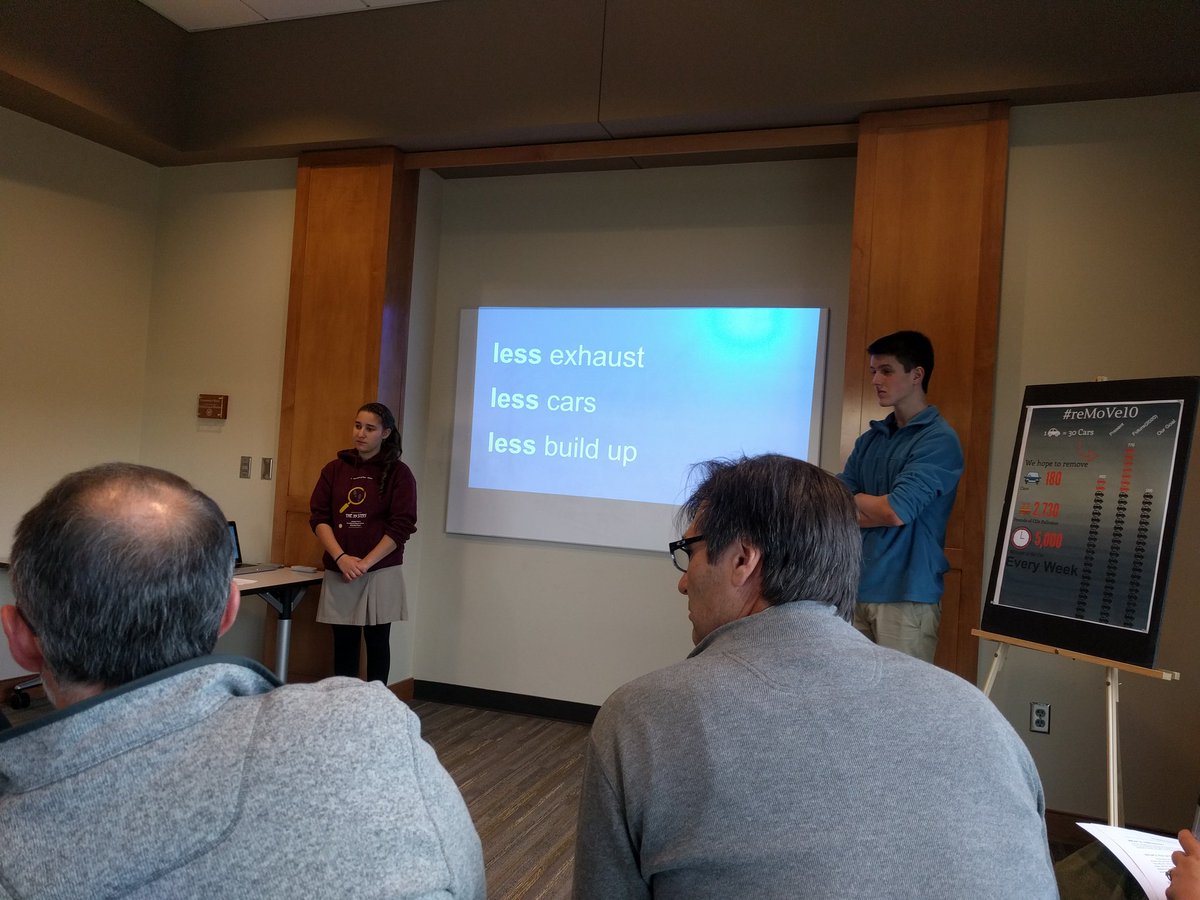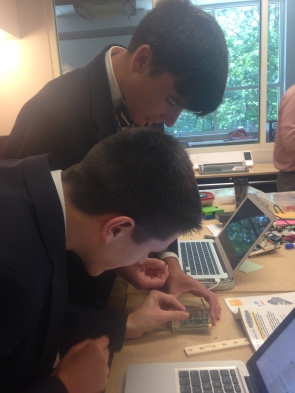The past few weeks I have been conversing with Mary and Cali Ragland, two seniors from Perkiomen Valley High School in Pennsylvania. These two are are currently taking an independent study course around the essential question: “How might we design an educational system that best meets the 21st learner’s needs by valuing curiosity?” They reached out to me after having been introduced by a teacher to some of my blog posts and learning about my work in the Education Transformation Movement. Furthermore, my work designing the AP Lang Collab Course last year, where I co-developed an AP Language and Composition course, was intriguing to them because they wanted to learn about how to push through the “dark night of the soul” in the life of an self-guided project.
These two have been doing some great work interviewing teachers and students and pulling away key insights about the role of curiosity in education. I especially love the quote that they describe as really encompassing what made them interested in education transformation:
“Education is not the filling of a pail, but the lighting of a fire.” – W.B. Yeats
I would definitely encourage reading more about their work on their blog: Curiosity in Education. Personally, talking to these two has been great because it’s reminded me of how far I’ve come in the past few years, and reminded me how important it is for me to always go back to where I started- this blog.
Senior year has made blogging very difficult because I have spent most of my “non homework writing time” working on college essays and scholarship applications. Then when I kind of have “free time” (which basically just means I have finished homework and have no planed activities or meetings at the time) I find myself wanting to savor the moment to take a break from intense mindfulness. However, I know how important it is to blog to not only share my story with others, but to reflect for myself and capture my learning journey. After all, I started this blog for me -not because I wanted hundreds of followers or felt like my voice was something that just had to be heard by others- I started it because of what I thought was a silly challenge to observe and reflect on the world more intently.
In fact, I haven’t blogged in so long that I haven’t yet reflected on the fact that I was approved to embark on another curriculum creation opportunity by designing my own Independent Project!!
For my last semester of high school I am exploring the connection point between film, change theory, and education which will also apply towards my last needed half of a social sciences credit. Often times social science credits are just assumed to be a history course, whether it be world history, US history, economics, US government, etc. However, social sciences by definition are “social” meaning, about human society and social relationships and how they function, which does explicitly mean just  “history.”
“history.”
I say “just history” because I believe everything involves some understanding of history, because everything has a history and thus History is Everywhere. An essential question to all learning is, “How can we use the knowledge we have gathered over time (the past) in order to better understand and design for our present and future?”
So yes I believe you could call my course a “history course” because I’m definitely researching the past. However, for my particular project, I really wanted to explore society from the perspective of how we create change in society to then apply this knowledge in the world of education. The final product of this work will be a high quality documentary video focused on the Innovation Diploma and the moment that I call the “clicking moment”; that moment when students realize that the world is changing and education should be too, and they start to take ownership of their learning in order to make a difference now, not “when they are grown up.”
Now the main reason I haven’t mentioned this project yet is because it was a last minute project that got put into double time in order to come to life. At the end of last semester I knew I wanted to devote more time second semester to exploring and contributing to the education transformation movement. However, I’m always so busy and yet their is a finite amount of time in the day. I had to figure out what in my daily schedule could give a little time. What I realized is that what I wanted to work on would likely hit a lot of social science credits, so we thought, “What if this was my ‘history’ class?”
I worked on overdrive with my mentors in order to put together a document to pitch the idea of an Independent Project to our administration. The end of the semester though was a very crazy time for me both in and out of school, so I got approved with the intent of needing the first few weeks of second semester to still work on the planning details.
One of the first tasks I had was to figure out how I would devote my ID time, especially after the reMoVe10 design brief gained so much momentum after first semester. The design brief given to us by the Mayor of Sandy Springs, was designed to be a project we worked on during a single semester. However, our school admin, representatives from the Sandy Springs Council, and our new partners at Georgia Commute Options all got so fired up about the work we’ve been doing, that we realized this project needed to continue. 
Because of this decision to change the scope of the project, our team had to look back at our team roles and norms and decide how best to continue based on plans that were already set for second semester. I already had plans to work on my Independent Project work, and another team mate was already in the process of another design brief opportunity. Therefore, we added a new member to our team, and I used the month of January to waning out of my position as team leader to make a smoother transition for the new team. My plan is to continue to work with the reMoVe10 team, but more as a consultant for them to help give feedback and provide assistance at specific events.
{Small necessary tangent: This last month was honestly really hard for me, because I naturally find myself in a leadership role in the sense of “project manager,” so it was challenging to work on stepping back and being a leader by pushing others to take a leadership role. However, I think it was something important for me to work on because part of a leaders role should always be to coach others to lead.}
 While continuing to work with the reMoVe10 team this past month, I used 4th period (my Independent Project time) to start further brainstorming what my video will look like, while getting a Film Course 101 tutorial from a mentor, and continuing to find ways I can discover and experiment with changes in education specifically in regards to the role of student voice. So far I’m diving deep into essential questions such as “What motivates people to learn?” “Where does ‘passion’ fit into education?” and “What gives students agency?” as my design drivers, though I believe as I start to interview people the story line will become even more clear.
While continuing to work with the reMoVe10 team this past month, I used 4th period (my Independent Project time) to start further brainstorming what my video will look like, while getting a Film Course 101 tutorial from a mentor, and continuing to find ways I can discover and experiment with changes in education specifically in regards to the role of student voice. So far I’m diving deep into essential questions such as “What motivates people to learn?” “Where does ‘passion’ fit into education?” and “What gives students agency?” as my design drivers, though I believe as I start to interview people the story line will become even more clear.
I’ve learned that with documentaries one of the best things to do is to just press record and start filming. So now that I’ve officially had my last day full time with the reMoVe10 team (last Wednesday) I’ve been gearing up to dive all in on this Independent Project using my 8 hours and 40 minutes a week (between ID time and my new Independent Project specific time) to research, film, and synthesize information about the social science of education change. We pushed “purchase” on some new awesome film equipment yesterday, and now the fun (and intense) work is about to really start!



 Partners:
Partners:
 We also created this info-graphic which we sent out to the MVPS community to gain support and focus group partners for the movement. We learned that we currently have 662 cars coming into MVPS every morning. Based on estimates for the growth of our school, we should have around 770 cars by the year 2020 when our new high school building is finished being built. With this projected growth rate, it’s imperative that we act now to decrease traffic. If we successfully cut traffic down by 10% now, then we will be decreasing the number of future cars by 180 cars, decreasing pollution by 2,730 lbs of CO2, and saving 5,000 minutes of time commuting as a community (based on the average distances families currently travel from in order to get to MVPS).
We also created this info-graphic which we sent out to the MVPS community to gain support and focus group partners for the movement. We learned that we currently have 662 cars coming into MVPS every morning. Based on estimates for the growth of our school, we should have around 770 cars by the year 2020 when our new high school building is finished being built. With this projected growth rate, it’s imperative that we act now to decrease traffic. If we successfully cut traffic down by 10% now, then we will be decreasing the number of future cars by 180 cars, decreasing pollution by 2,730 lbs of CO2, and saving 5,000 minutes of time commuting as a community (based on the average distances families currently travel from in order to get to MVPS).



 people with the app associated with the Mount Vernon community.
people with the app associated with the Mount Vernon community.
 This Tuesday we have another client meeting with our partners from the City of Sandy Springs so it’s been a crazy week for our project team. The main things we’ve accomplished since
This Tuesday we have another client meeting with our partners from the City of Sandy Springs so it’s been a crazy week for our project team. The main things we’ve accomplished since 

 New year, new team, new venture.
New year, new team, new venture. anyone in the community can generate. Essentially, we’re creating a pool of potential projects that are not out of a textbook or dreamed up by a teacher, but instead projects that are generated out of need in the community.-
anyone in the community can generate. Essentially, we’re creating a pool of potential projects that are not out of a textbook or dreamed up by a teacher, but instead projects that are generated out of need in the community.- 

